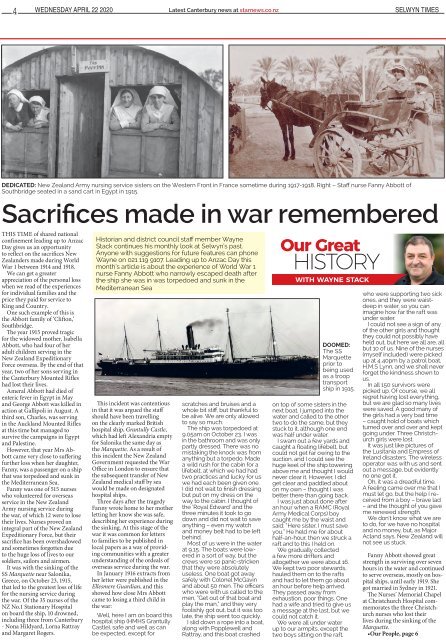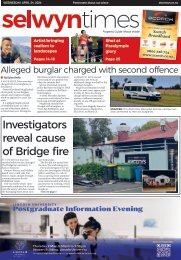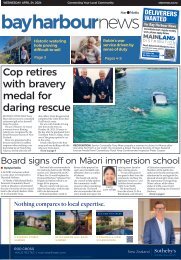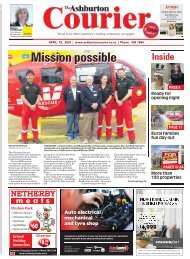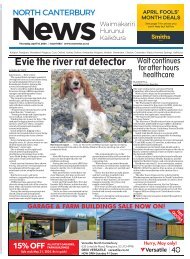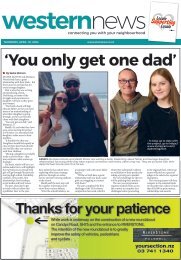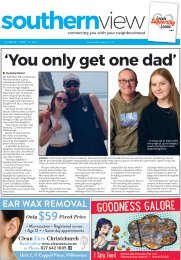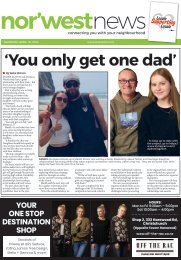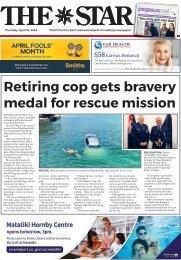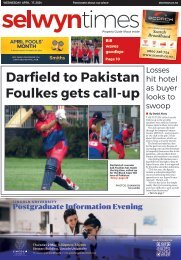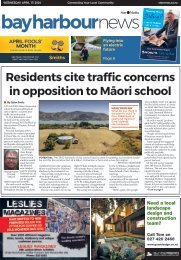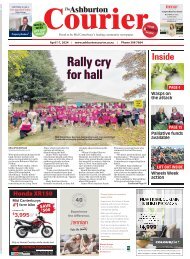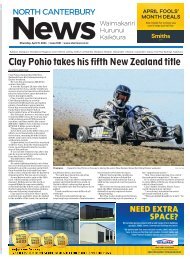Selwyn Times: April 22, 2020
You also want an ePaper? Increase the reach of your titles
YUMPU automatically turns print PDFs into web optimized ePapers that Google loves.
4 Wednesday <strong>April</strong> <strong>22</strong> <strong>2020</strong><br />
Latest Canterbury news at starnews.co.nz<br />
SELWYN TIMES<br />
DEDICATED: New Zealand Army nursing service sisters on the Western Front in France sometime during 1917-1918. Right – Staff nurse Fanny Abbott of<br />
Southbridge seated in a sand cart in Egypt in 1915.<br />
Sacrifices made in war remembered<br />
THIS TIME of shared national<br />
confinement leading up to Anzac<br />
Day gives us an opportunity<br />
to reflect on the sacrifices New<br />
Zealanders made during World<br />
War 1 between 1914 and 1918.<br />
We can get a greater<br />
appreciation of the personal loss<br />
when we read of the experiences<br />
for individual families and the<br />
price they paid for service to<br />
King and Country.<br />
One such example of this is<br />
the Abbott family of ‘Clifton,’<br />
Southbridge.<br />
The year 1915 proved tragic<br />
for the widowed mother, Isabella<br />
Abbott, who had four of her<br />
adult children serving in the<br />
New Zealand Expeditionary<br />
Force overseas. By the end of that<br />
year, two of her sons serving in<br />
the Canterbury Mounted Rifles<br />
had lost their lives.<br />
Ameral Abbott had died of<br />
enteric fever in Egypt in May<br />
and George Abbott was killed in<br />
action at Gallipoli in August. A<br />
third son, Charles, was serving<br />
in the Auckland Mounted Rifles<br />
at this time but managed to<br />
survive the campaigns in Egypt<br />
and Palestine.<br />
However, that year Mrs Abbott<br />
came very close to suffering<br />
further loss when her daughter,<br />
Fanny, was a passenger on a ship<br />
that was torpedoed and sunk in<br />
the Mediterranean Sea.<br />
Fanny was one of 515 nurses<br />
who volunteered for overseas<br />
service in the New Zealand<br />
Army nursing service during<br />
the war, of which 12 were to lose<br />
their lives. Nurses proved an<br />
integral part of the New Zealand<br />
Expeditionary Force, but their<br />
sacrifice has been overshadowed<br />
and sometimes forgotten due<br />
to the huge loss of lives to our<br />
soldiers, sailors and airmen.<br />
It was with the sinking of the<br />
SS Marquette near Salonika,<br />
Greece, on October 23, 1915,<br />
that led to the greatest loss of life<br />
for the nursing service during<br />
the war. Of the 35 nurses of the<br />
NZ No.1 Stationary Hospital<br />
on board the ship, 10 drowned,<br />
including three from Canterbury<br />
- Nona Hildyard, Lorna Rattray<br />
and Margaret Rogers.<br />
Historian and district council staff member Wayne<br />
Stack continues his monthly look at <strong>Selwyn</strong>’s past.<br />
Anyone with suggestions for future features can phone<br />
Wayne on 021 119 9107. Leading up to Anzac Day this<br />
month’s article is about the experience of World War 1<br />
nurse Fanny Abbott who narrowly escaped death after<br />
the ship she was in was torpedoed and sunk in the<br />
Mediterranean Sea<br />
This incident was contentious<br />
in that it was argued the staff<br />
should have been travelling<br />
on the clearly marked British<br />
hospital ship, Grantully Castle,<br />
which had left Alexandria empty<br />
for Salonika the same day as<br />
the Marquette. As a result of<br />
this incident the New Zealand<br />
Government requested the War<br />
Office in London to ensure that<br />
the subsequent transfer of New<br />
Zealand medical staff by sea<br />
would be made on designated<br />
hospital ships.<br />
Three days after the tragedy<br />
Fanny wrote home to her mother<br />
letting her know she was safe,<br />
describing her experience during<br />
the sinking. At this stage of the<br />
war it was common for letters<br />
to families to be published in<br />
local papers as a way of providing<br />
communities with a greater<br />
understanding of the ordeals of<br />
overseas service during the war.<br />
In January 1916 extracts from<br />
her letter were published in the<br />
Ellesmere Guardian, and this<br />
showed how close Mrs Abbott<br />
came to losing a third child in<br />
the war:<br />
Well, here I am on board this<br />
hospital ship (HMHS Grantully<br />
Castle), safe and well as can<br />
be expected, except for<br />
scratches and bruises and a<br />
whole bit stiff, but thankful to<br />
be alive. We are only allowed<br />
to say so much.<br />
The ship was torpedoed at<br />
9.05am on October 23. I was<br />
in the bathroom and was only<br />
partly dressed. There was no<br />
mistaking the knock was from<br />
anything but a torpedo. Made<br />
a wild rush for the cabin for a<br />
lifebelt, at which we had had<br />
two practices and lucky for us<br />
we had each been given one.<br />
I did not wait to finish dressing<br />
but put on my dress on the<br />
way to the cabin. I thought of<br />
the ‘Royal Edward’ and the<br />
three minutes it took to go<br />
down and did not wait to save<br />
anything – even my watch<br />
and money belt had to be left<br />
behind.<br />
Most of us were in the water<br />
at 9.15. The boats were lowered<br />
in a sort of way, but the<br />
crews were so panic-stricken<br />
that they were absolutely<br />
useless. One boat got away<br />
safely with Colonel McGavin<br />
and about 50 men. The officers<br />
who were with us called to the<br />
men, “Get out of that boat and<br />
play the man,” and they very<br />
foolishly got out, but it was too<br />
late, the ship went too quickly.<br />
I slid down a rope into a boat,<br />
along with Popplewell and<br />
Rattray, and this boat crashed<br />
Our Great<br />
history<br />
WITH WAYNE STACK<br />
DOOMED:<br />
The SS<br />
Marquette<br />
prior to<br />
being used<br />
as a troop<br />
transport<br />
ship in 1915.<br />
on top of some sisters in the<br />
next boat. I jumped into the<br />
water and called to the other<br />
two to do the same, but they<br />
stuck to it, although one end<br />
was half under water.<br />
I swam out a few yards and<br />
caught a floating lifebelt, but<br />
could not get far owing to the<br />
suction, and I could see the<br />
huge keel of the ship towering<br />
above me and thought I would<br />
never clear it. However, I did<br />
get clear and paddled about<br />
on my own – thought I was<br />
better there than going back.<br />
I was just about done after<br />
an hour when a RAMC (Royal<br />
Army Medical Corps) boy<br />
caught me by the waist and<br />
said: “Here sister, I must save<br />
you.” He held me for about<br />
half-an-hour, then we struck a<br />
raft and to this I held on.<br />
We gradually collected<br />
a few more drifters and<br />
altogether we were about 16.<br />
We kept two poor stewards,<br />
hauled them on to the rafts<br />
and had to let them go about<br />
an hour before help arrived.<br />
They passed away from<br />
exhaustion, poor things. One<br />
had a wife and tried to give us<br />
a message at the last, but we<br />
could not catch it.<br />
We were all under water<br />
up to our armpits, except the<br />
two boys sitting on the raft,<br />
who were supporting two sick<br />
ones, and they were waistdeep<br />
in water, so you can<br />
imagine how far the raft was<br />
under water.<br />
I could not see a sign of any<br />
of the other girls and thought<br />
they could not possibly have<br />
held out, but here we all are, all<br />
but 10 of us. Nine of the nurses<br />
(myself included) were picked<br />
up at 4.40pm by a patrol boat,<br />
H.M.S Lynn, and we shall never<br />
forget the kindness shown to<br />
us.<br />
In all 150 survivors were<br />
picked up. Of course, we all<br />
regret having lost everything,<br />
but we are glad so many lives<br />
were saved. A good many of<br />
the girls had a very bad time<br />
– caught hold of boats which<br />
turned over and over and kept<br />
going under. Three Christchurch<br />
girls were lost.<br />
It was just like pictures of<br />
the Lusitania and Empress of<br />
Ireland disasters. The wireless<br />
operator was with us and sent<br />
out a message, but evidently<br />
no one got it.<br />
Oh, it was a dreadful time.<br />
A feeling came over me that I<br />
must let go, but the help I received<br />
from a boy – brave lad<br />
– and the thought of you gave<br />
me renewed strength.<br />
We don’t know what we are<br />
to do, for we have no hospital<br />
and no money, but, as Major<br />
Acland says, New Zealand will<br />
not see us stuck.<br />
Fanny Abbott showed great<br />
strength in surviving over seven<br />
hours in the water and continued<br />
to serve overseas, mostly on hospital<br />
ships, until early 1919. She<br />
got married in Sydney in 1921.<br />
The Nurses’ Memorial Chapel<br />
at Christchurch Hospital commemorates<br />
the three Christchurch<br />
nurses who lost their<br />
lives during the sinking of the<br />
Marquette.<br />
•Our People, page 6


